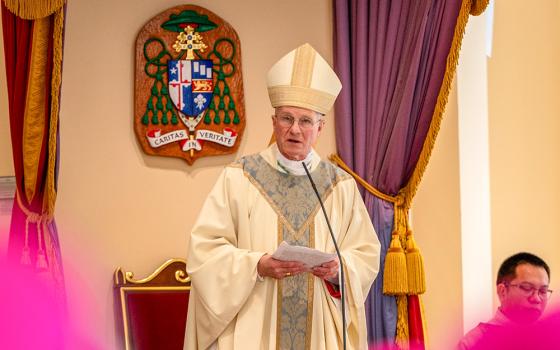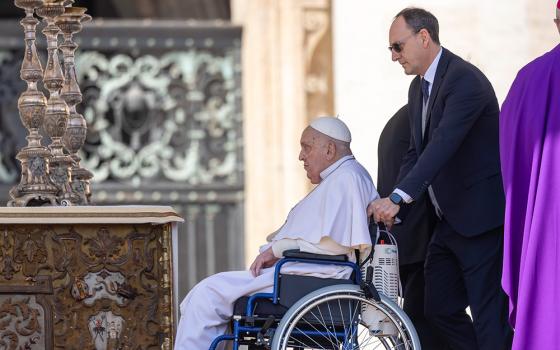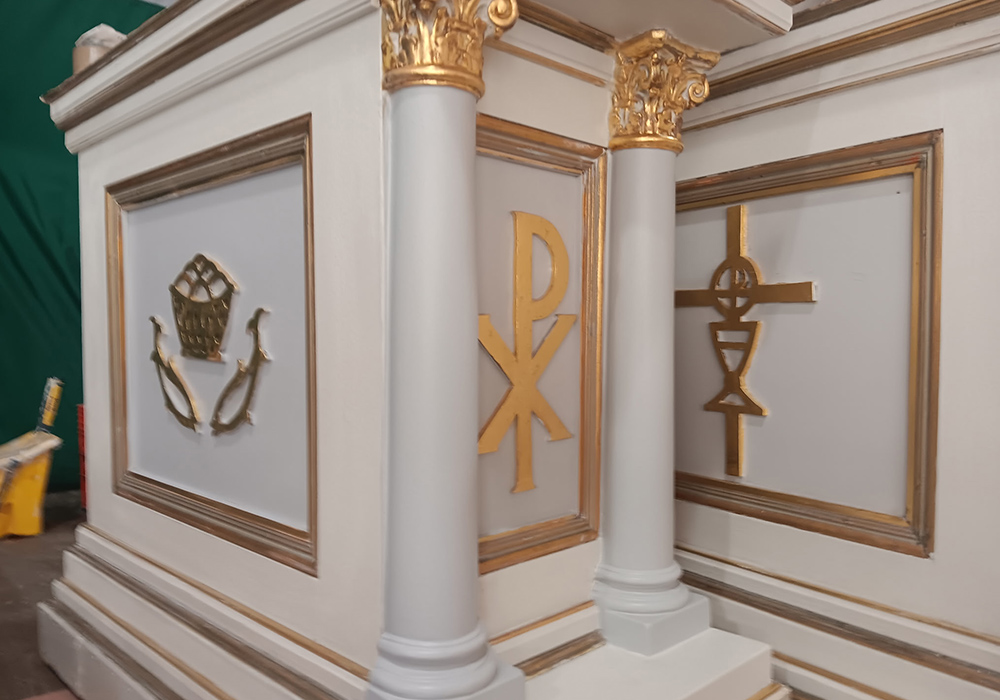
Former parishioners of St. Elizabeth of Hungary Church in Cleveland had been disappointed and angered to learn that a historic Vatican II altar had been dismantled in January 2024. The altar is now restored and back in use. Pedestals of the restored altar are pictured, before it was returned. (Courtesy of Mark Yonke)
A historic Vatican II altar that had been dismantled at the former St. Elizabeth of Hungary Church in Cleveland, is now restored and back in use for community gatherings.
"It looks great," said Bob Purgert, 72, a member of the former parish in Cleveland's economically struggling Buckeye neighborhood.
The altar restoration involved reattaching the altar top to its two pedestals, piecing together wooden parts that had been chipped and splintered, restoring gold leaf details and installing new and sturdier casters.
It was completed in time for the community's annual celebration last Nov. 17, on the feast of St. Elizabeth of Hungary, the saint known for her charitable works.
Several former parishioners had been disappointed and angered to learn that the altar had been dismantled last January. They immediately contacted Cleveland diocesan officials, which led to a series of meetings to have the altar restored and put back in the church.
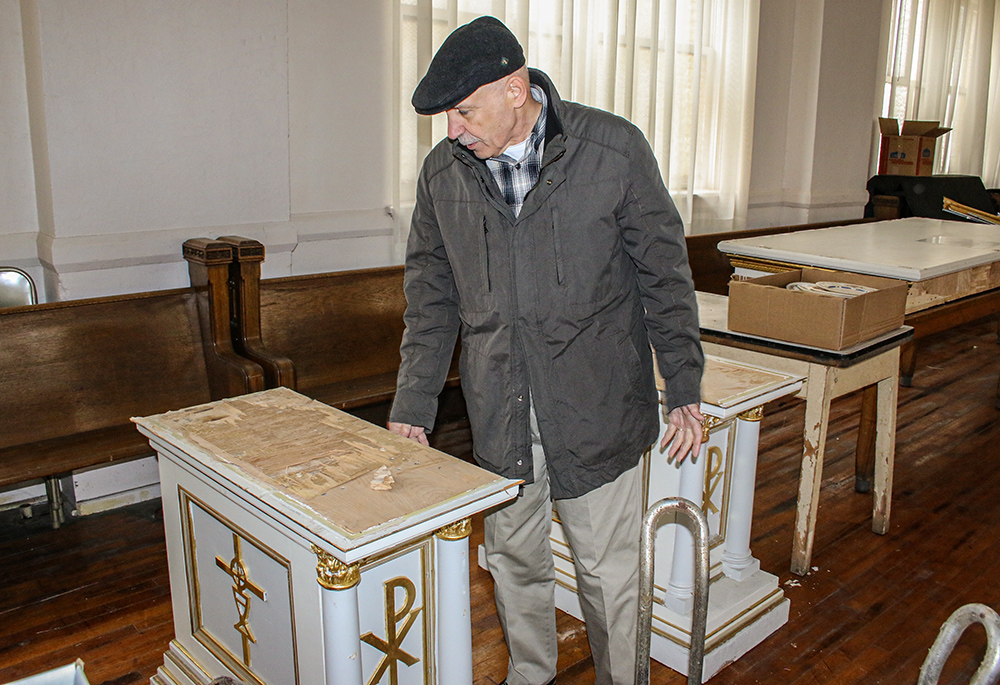
Bob Purgert looks at one of the damaged pedestals of the dismantled altar at St. Elizabeth of Hungary Church in Cleveland, in a 2024 photo. Burgert and several other former parishioners of St. Elizabeth were disappointed and angered to learn that the altar had been dismantled in January 2024. (Dennis Sadowski)
The dismantlement occurred several months after Cleveland Bishop Edward Malesic merged St. Elizabeth with another Hungarian parish across town, St. Emeric. At that time he also welcomed the Chicago-based Institute of Christ the King Sovereign Priest, a group whose priests celebrate the traditional Latin Mass, to St. Elizabeth Church. The 2023 announcement said the church would become a shrine where the institute's priests could celebrate the Latin Mass for Catholics who desired a place to worship under the old rite.
The bishop also said the parish merger was necessary as Mass attendance at St. Elizabeth had declined for years. He allowed St. Elizabeth of Hungary parishioners to use their former church for baptisms, weddings, funerals and special events. The church, established in 1892, was the first parish in the Western Hemisphere for the Hungarian diaspora.
Months after the merger took place, Rodney Johnson, a security guard at the church said he recalled entering St. Elizabeth during morning rounds and saw a worker, who described himself as a carpenter, working to take apart the altar while Fr. Jeffery Weaver, a diocesan priest who celebrated the Latin Mass on weekdays at the shrine, was standing nearby.
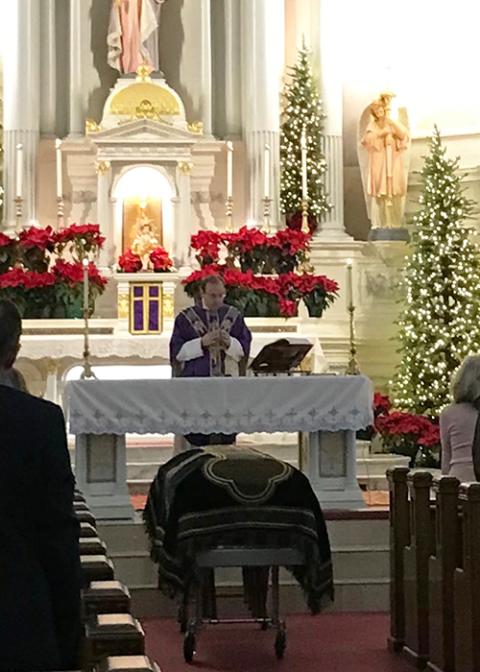
Fr. Richard Bona presided at the funeral Mass for longtime St. Elizabeth of Hungary parishioner Margaret German on Jan. 3. The altar was restored in November. (Courtesy of Mark Yonke)
Johnson said that when he told Weaver that parishioners would be upset over the altar's destruction, the priest responded that "it was just a table."
Weaver had been presiding at weekday Latin Masses and assisting at the Sunday Mass alongside shrine rector Fr. James Hoogerwerf, who uses the title "canon" as the institute designates its priest leaders.
Mark Yonke, 58, a former parishioner of St. Elizabeth Church — whose grandparents appear in photos of parish organizations from 1904 in a museum in the church basement — said the institute paid the cost of repair, totaling $9,500.
He told National Catholic Reporter that parishioners had been told that the dismantling was the result of "a misunderstanding."
He expressed satisfaction that the work was completed in time for the funerals in December and January, respectively, of two lifelong St. Elizabeth members, Mary Spisak and Margaret German. Both women had protested the dismantling of the altar to the diocese.
"It shows why the altar is important to the Hungarian community," Yonke said.
Tim Haas, owner of Decorative Artworks Inc. in nearby Newbury, which specializes in restoring religious artifacts and churches, said he and a coworker completed the job in nine days in November. He confirmed the cost of the work, saying payment from the institute soon followed completion.
"I wondered, 'Why did they need to do that [dismantling]?' I didn't understand it one bit. Why did they need to take it apart and damage it so much," Haas recalled thinking after seeing the damage prior to submitting his bid for the job.
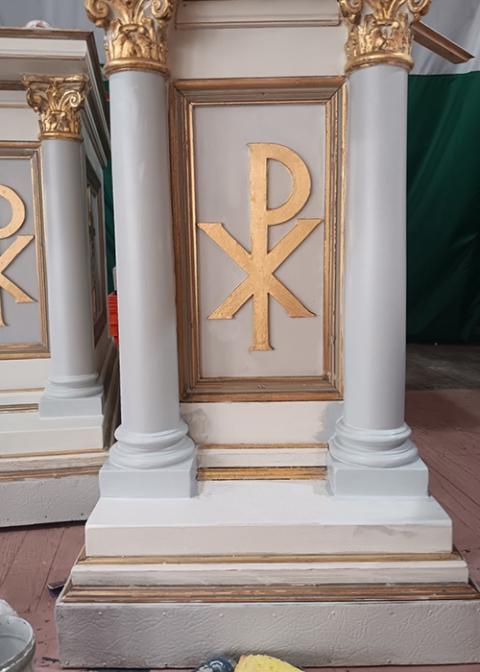
The altar restoration was completed in time for the community's annual celebration last Nov. 17, on the feast of St. Elizabeth of Hungary. (Courtesy of Mark Yonke)
St. Elizabeth Church is familiar to Haas, one of three bidders on the altar project. In 2016 his company repaired water damage there.
Parish priest Fr. Julius Zahorszky built the altar in 1966 to accommodate the liturgical reforms of the Second Vatican Council. Hungarian Cardinal József Mindszenty celebrated Mass at the altar during a 1974 visit to the parish. Pope Francis declared the cardinal, who resisted Hungary's communist government after World War II, venerable in 2019, making the altar a second-class relic if he is canonized a saint.
At the time the dismantling was discovered, Weaver was listed on the Cleveland diocesan website as "awaiting assignment."
In an emailed response to questions about the institute's responsibility to restore the altar and Weaver's status in the diocese, Nancy Fishburn, diocesan executive director for communications, wrote that a lease agreement between the institute and St. Emeric Parish established "the rights and responsibilities to the church and other facilities at the Shrine of St. Elizabeth of Hungary."
"The parish and the institute share the goal of promoting the good news of Jesus Christ and are committed to open communication to ensure no further misunderstandings occur and a positive relationship is maintained," she wrote.
As for Weaver, her message said he "is no longer engaged in public ministry and, as such, has no role at the Shrine of St. Elizabeth of Hungary or with the Institute."
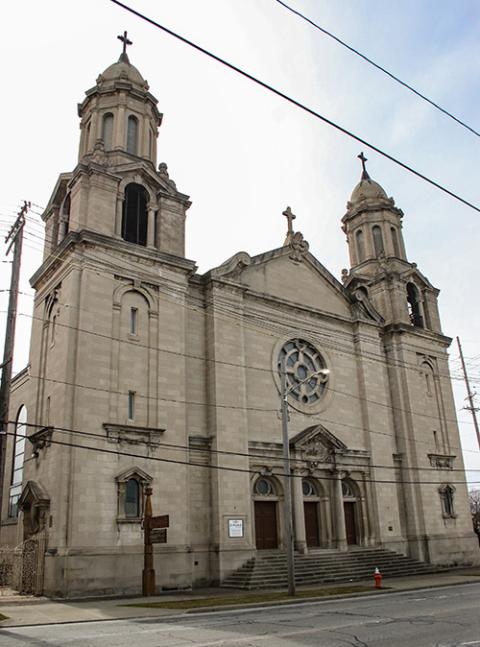
St. Elizabeth of Hungary Church in Cleveland (Dennis Sadowski)
She declined to answer follow up questions about Weaver, writing that the diocese has "nothing further to add to our response."
As NCR reported in May 2024, Weaver was on leave from the priesthood for a decade following allegations that he "groomed" and attempted to sexually abuse a teenager before being reinstated to ministry by Bishop Richard Lennon in 2012.
The priest initially asked for the leave in 2002 as reporting on the clerical sexual abuse crisis in the Catholic Church peaked and he admitted to an inappropriate sexual advance toward a young man in Lake County, adjacent to Cuyahoga County, where Cleveland is located.
No explanation was given by the diocese at the time of Weaver's reinstatement.
Weaver was not charged with a crime following an investigation into the alleged abuse by the Lake County prosecutor's office. A Cuyahoga County judge in Cleveland subsequently sealed the file.
Weaver could not be reached for this story and neither the institute in Chicago nor Hoogerwerf responded to multiple emails.
Advertisement
Former parishioners are pleased to see the new altar in place.
"I'm glad it was finally done," said Lenny Toth, 72, who recalled serving Mass "at that altar when I was younger" as well as at his father's funeral in 1978.
"It was sacrilegious about the dismantling," he said. "If there was a priest present, that was a mortal sin. That altar is a relic."
He added that the Hungarian community has expressed a desire to work with the institute to share the use of the church, but that any outreach seemed not to have been welcomed by the Latin Mass group to his disappointment.
Virginia Kachmar, 76, who lives near the church, said the restoration "really does look nice," complimenting Haas for doing "a magnificent job."
"Fortunately, they saved every piece that they took apart. They had all the pieces," she said.

